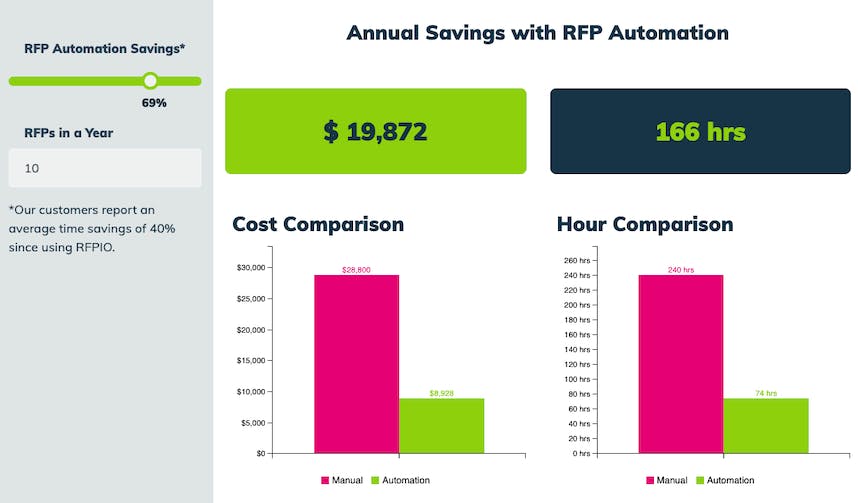The IT sector is highly competitive and innovation is the currency that separates successful technology companies from the rest. Maintaining innovation was even revealed as one of the top 5 challenges the tech industry needs to be prepared for.
Tech industry organizations must maintain a balance, continually innovating to gain a competitive edge with their products or services while using the latest technologies for optimizing their internal operations.
As a Subject Matter Expert (SME) at a technology company, your expertise is often called upon to help maintain that balance. It is especially valuable when new business is on the table and your knowledge elevates the quality of an IT RFP response.
In the following IT RFP response guide, you’ll learn the most efficient methods for contributing to your organization’s success. The next time your expertise is summoned for an RFP, you’ll be ready.
The IT RFP response guide for SMEs
1. Show more value to your revenue team
What’s the main difference between top-performing SMEs and average SMEs? They show more value by directly contributing their expertise to the organization’s revenue-generating objectives.
Responding to RFPs is one of the key opportunities for winning new business. Revenue teams include people from sales, marketing, support, and customer success. An SME at a technology company is also part of this revenue team. Their contributions are needed to refine details that can influence a deal.
You’re busy. Revenue is only part of your overall responsibilities. If you are willing to make time to contribute to revenue-generating objectives like RFPs, you’ll show more value to both your revenue team and your organization.
2. Make the process more efficient with technology
On the heels of participation in the process comes a willingness to make the process better than before. Technology is often the missing ingredient for continued innovation. Ironically, technology organizations and IT teams are stuck in the old, manual way of response management. They live in spreadsheets and Google folders instead of a technologically advanced platform.
A response management platform like RFPIO saves companies time and resources when they are responding to ANY type of business query. That business query could be an RFx (including RFPs, RFIs, etc.) or any form of security questionnaires (Security Questionnaires Lite, VSAQ, CAIQ, VSA, etc.). That business query could also be the repetitive technical questions you receive from your sales team.
No matter the type of response, using technology like a response management platform offers a single login application for you to quickly locate, filter, and populate the answers to these questions. It also integrates with popular solutions (like Slack, Salesforce, Sharepoint, and Microsoft Teams) to improve collaboration.

3. Communicate to keep the RFP project on target
Often you are the one creating highly technical content within an RFP response. Be clear on the requirements so you understand exactly what the issuer needs to know. If you reuse an older response that doesn’t meet that requirement, then you might affect your organization’s chances of capturing new business.
Being that the tech space is so competitive, another company is typically right behind yours all the way through the sales process. Before diving into your response or section, clarify the details and language with your proposal management lead—or connect with the issuer directly.
4. Position your organization as a security expert
Security-related questions are becoming an everyday occurrence in the high-tech space. Because you’re the technical subject matter expert, security questionnaires inevitably end up “on your desk.” While these can be daunting documents, it’s also easy to understand that the issuer is only doing their due diligence before committing to a vendor partnership.
To put your potential partner at ease, you’ll want to show that your organization takes their security seriously by taking security questionnaires seriously. Since these vendor assessments often have hundreds of questions, your best bet is to lean on a response management platform to bulk-answer and import/export smoothly.
“RFPIO helped us build a scalable, repeatable process for handling a large number of RFPs, IT security questionnaires, due diligence forms, and vendor applications. This system allows us to easily invite multiple contributors, authors, SMEs, and reviewers at a Project, Section, and Questions level.” – Gavin O’Donoghue, Global RFP Manager at Cision
5. Participate in the review workflow
Before you are brought into the RFP response process, a typical RFP has been touched by a group of people, possibly including: a proposal writer, a proposal manager, a sales manager, and a marketing manager. It’s your responsibility to ensure relevancy and accuracy with technical responses whenever a non-SME drafts the content first.
The review process can be confusing and you may not know where your place is within that workflow. Rather than skipping the review cycles in favor of other priorities, be the SME that establishes some ground rules so everyone is clear on timing. If your organization is missing an RFP response process, use this one as your guide.
6. Keep the best content relevant
Over time, every business evolves. But a technology company evolves even faster. Successful response management is rooted in consistent content management. Having a centralized knowledge repository is a step in the right direction. Maintaining that repository is the next—often forgotten—step.
RFPIO offers an Content Library for storing and organizing all of your responses. A quarterly content audit should be performed to keep company information updated. To audit your content consistently, simply set up custom reminders at a cadence of your choosing.
Even if you have a proposal manager who handles content audits, that person will not know the latest technical info like you do. By stepping in to regularly help with content audits, you’ll make the process faster the next time a business query arrives. Content will be current, so you can customize and plug in responses without starting with a blank page.
